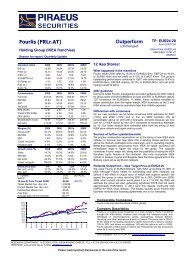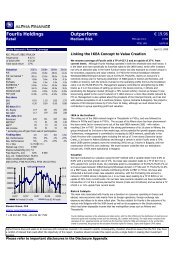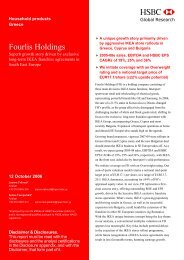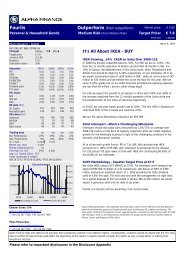European small and mid caps-Stock picks Q4 2007-Q1 2008 - Fourlis
European small and mid caps-Stock picks Q4 2007-Q1 2008 - Fourlis
European small and mid caps-Stock picks Q4 2007-Q1 2008 - Fourlis
Create successful ePaper yourself
Turn your PDF publications into a flip-book with our unique Google optimized e-Paper software.
Mid cap<br />
<strong>European</strong> <strong>small</strong> <strong>and</strong> <strong>mid</strong> <strong>caps</strong><br />
17 October <strong>2007</strong><br />
abc<br />
We expect large <strong>caps</strong> to continue to outperform.<br />
Larger companies tend to be less dependent on the<br />
vagaries of the business cycle, partly by virtue of<br />
their greater international diversification. They<br />
have stronger balance sheets <strong>and</strong> are likely to be<br />
relatively sheltered from any residual liquidity<br />
pressures. When M&A revives, we suspect its<br />
focus will shift upscale – partly because private<br />
equity may become a little less prominent <strong>and</strong><br />
partly because many of the potential targets in the<br />
<strong>small</strong>/<strong>mid</strong>-cap space have already been snapped<br />
up <strong>and</strong>/or have become too expensive. Recently,<br />
large <strong>caps</strong> have been trading more cheaply than<br />
<strong>small</strong> <strong>and</strong> <strong>mid</strong>-cap companies, both in terms of<br />
PEs <strong>and</strong> dividend yields.<br />
And not all large <strong>caps</strong> look equally attractive.<br />
Most utilities, for example, are large simply by<br />
virtue of their physical assets <strong>and</strong> their earnings<br />
are non-cyclical. However, for us, their earnings<br />
are too defensive, their balance sheets are not the<br />
strongest <strong>and</strong> there has already been a wave of<br />
consolidation in the sector, so we see less<br />
consolidation to look forward to. There are many<br />
<strong>small</strong> technology companies, for example, that we<br />
would buy ahead of larger utilities.<br />
Other things being equal, though, we think investors<br />
will continue to ‘think big’ over the course of the rest<br />
of <strong>2007</strong> <strong>and</strong> into <strong>2008</strong>.<br />
As with other intra-market themes, however, we<br />
do not expect size to prove overwhelmingly<br />
important: we simply expect <strong>small</strong>er-cap indices<br />
to rise less markedly than their large-cap peers.<br />
Some of the post-2000 outperformance by <strong>mid</strong> <strong>and</strong><br />
<strong>small</strong> <strong>caps</strong> has reflected a structural decision by<br />
many money managers to increase their exposure<br />
to what they see as relatively under-researched<br />
<strong>and</strong>, hence (arguably), less efficiently priced<br />
segments of the global market. Smaller <strong>caps</strong> –<br />
together with emerging markets, their regional<br />
equivalents, perhaps – have benefited accordingly.<br />
This shift is unlikely to be reversed any time soon,<br />
in our opinion.<br />
Price relatives: <strong>small</strong> & <strong>mid</strong> cap indices versus large <strong>caps</strong><br />
200<br />
160<br />
120<br />
80<br />
40<br />
97 98 99 00 01 02 03 04 05 06 07<br />
UK US Germany Japan<br />
PE relatives: <strong>small</strong> & <strong>mid</strong> cap indices versus large <strong>caps</strong><br />
180<br />
160<br />
140<br />
120<br />
100<br />
80<br />
60<br />
40<br />
97 98 99 00 01 02 03 04 05 06 07<br />
UK US Germany Japan<br />
Source: HSBC, Thomson Financial Datastream<br />
Source: HSBC, Thomson Financial Datastream<br />
5







